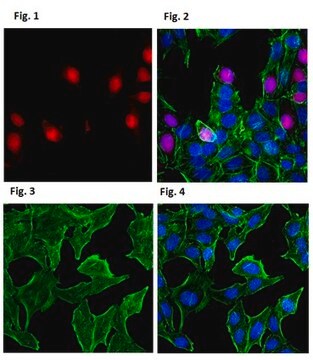推薦產品
生物源
mouse
品質等級
抗體表格
purified antibody
抗體產品種類
primary antibodies
無性繁殖
4.2.2, monoclonal
物種活性
pig, canine, human, mouse, rat, monkey, bovine
技術
immunocytochemistry: suitable
immunoprecipitation (IP): suitable
western blot: suitable
同型
IgG2aκ
NCBI登錄號
UniProt登錄號
運輸包裝
wet ice
目標翻譯後修改
unmodified
基因資訊
bovine ... Irs1(538598)
dog ... Irs1(486148)
human ... IRS1(3667)
mouse ... Irs1(16367)
pig ... Irs1(100512686)
rat ... Irs1(25467)
rhesus monkey ... Irs1(707870)
一般說明
IRS1 (Insulin Receptor Substrate 1) transmits insulin signals via metabolic and mitogenic pathways. IRS1 is heavily phosphorylated on both serine and tyrosine residues. These phosphorylated tyrosines enable IRS to act as a docking protein that binds SH2 domains of such proteins as PI3 Kinase (phosphatidylinositol 3-kinase) and GRB2, resulting in activation. Over expression and phosphorylation of serine is associated with insulin resistance and breast cancer. Some of the more notable phosphorylation sites are Ser302 that is phosphorylated following insulin stimulation. Ser307, phosphorylated by JNK and IKK, is a key regulatory site that appears to disrupt the IRS1/IR interaction and inhibits insulin-mediated activation of the PI3 kinase and MAPK pathways, and Ser636/639 that is known to be phosphorylated by p70S6K downstream of mTOR and acts as a negative feedback loop.
特異性
Predicted to cross-react with many other species based on 100% sequence homology with immunogen.
This antibody recognizes IRS1.
免疫原
Synthetic peptide corresponding to amino acids 431-446 of mouse IRS1.
應用
This Anti-IRS1 Antibody, clone 4.2.2 is validated for use in WB, IP, IC for the detection of IRS1.
品質
Evaluated by western blot on IR/IRS1 transfected CHO +/- Insulin lysate.
Western Blot Analysis:
1:1,000 dilution of this antibody was used to detect IRS1 in IRS/IR transfected CHO -/+ Calyculin A/ Okadaic Acid-treated cell lysate.
Western Blot Analysis:
1:1,000 dilution of this antibody was used to detect IRS1 in IRS/IR transfected CHO -/+ Calyculin A/ Okadaic Acid-treated cell lysate.
標靶描述
~185 kDa
外觀
Format: Purified
Purified mouse monoclonal antibody in buffer containing 0.1 M Tris-Glycine (pH 7.4),150 mM NaCl with 0.05% sodium azide.
其他說明
Concentration: Please refer to the Certificate of Analysis for the lot-specific concentration.
未找到適合的產品?
試用我們的產品選擇工具.
儲存類別代碼
12 - Non Combustible Liquids
水污染物質分類(WGK)
WGK 1
閃點(°F)
Not applicable
閃點(°C)
Not applicable
分析證明 (COA)
輸入產品批次/批號來搜索 分析證明 (COA)。在產品’s標籤上找到批次和批號,寫有 ‘Lot’或‘Batch’.。
Yunxue Guo et al.
International journal of biological sciences, 8(10), 1408-1417 (2012-12-01)
Generally, most miRNAs that were up-regulated during differentiation promoted adipogenesis, but our research indicated that up-regulation of miR-145 in porcine preadipocytes did not promote but inhibit adipogenesis. In this study, miR-145 was significantly up-regulated during porcine dedifferentiated fat (DFAT) cells
Rapamycin has a biphasic effect on insulin sensitivity in C2C12 myotubes due to sequential disruption of mTORC1 and mTORC2.
Ye, L; Varamini, B; Lamming, DW; Sabatini, DM; Baur, JA
Frontiers in Genetics null
Nancy J Hançer et al.
The Journal of biological chemistry, 289(18), 12467-12484 (2014-03-22)
IRS1 and IRS2 are key substrates of the insulin receptor tyrosine kinase. Mass spectrometry reveals more than 50 phosphorylated IRS1 serine and threonine residues (Ser(P)/Thr(P) residues) in IRS1 from insulin-stimulated cells or human tissues. We investigated a subset of IRS1
Gang Xi et al.
The Journal of biological chemistry, 292(5), 2009-2020 (2016-12-23)
Diabetes is a major risk factor for the development of atherosclerosis, but the mechanism by which hyperglycemia accelerates lesion development is not well defined. Insulin and insulin-like growth factor I (IGF-I) signal through the scaffold protein insulin receptor substrate 1
Yuji Shi et al.
Nature structural & molecular biology, 21(6), 522-527 (2014-05-13)
The biological function of the PTEN tumor suppressor is mainly attributed to its lipid phosphatase activity. This study demonstrates that mammalian PTEN is a protein tyrosine phosphatase that selectively dephosphorylates insulin receptor substrate-1 (IRS1), a mediator of insulin and IGF
我們的科學家團隊在所有研究領域都有豐富的經驗,包括生命科學、材料科學、化學合成、色譜、分析等.
聯絡技術服務